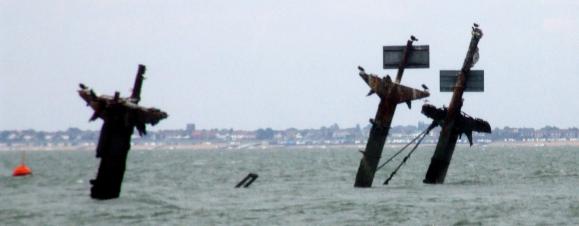 Three rusting masts rise from the Thames Estuary, off Sheppy Island, not far from Sheerness. They are the masts that once supported the swinging booms on the Liberty ship USS Richard Montgomery, which sank with a cargo of high explosive bombs and other munitions in 1944. The wreck still contains an estimated 1,400 tonnes of potentially highly volatile explosives. The remaining munitions are too dangerous to remove and also too dangerous to ignore.
Three rusting masts rise from the Thames Estuary, off Sheppy Island, not far from Sheerness. They are the masts that once supported the swinging booms on the Liberty ship USS Richard Montgomery, which sank with a cargo of high explosive bombs and other munitions in 1944. The wreck still contains an estimated 1,400 tonnes of potentially highly volatile explosives. The remaining munitions are too dangerous to remove and also too dangerous to ignore.
Now, the Ministry of Defence is offering to pay £5 million ‘danger money’ to any company prepared to hack off the rusting masts of the ship that the BBC has referred to as the “ticking time bomb of the Thames.” The concerns are that the rusting masts could waste away and fall onto the munitions, potentially causing a detonation.
As we posted last year, the Royal Military College of Science warned in 1970 that if the remaining bombs blew up, the force of the explosion would create a 3,000 meter-high column of water and a five meter-high tidal wave would swamp Sheerness and its 11,000 residents and travel up the Thames.
For most of the intervening period since the ship sank, the strategy has been to monitor the condition of the wreck and its dangerous cargo, rather than attempt to raise the high explosives in the 9,000 shells and bombs still believed to be in the ship’s holds.
A previous attempt to salvage a similar ship did not end well. When an attempt was made, in 1967, to salvage the munitions ship, Kielce, which sank in the English Channel off Folkstone, there was an explosion equivalent to an earthquake measuring 4.5 on the Richter scale, digging a 20-foot-deep (6 m) crater in the seabed and bringing “panic and chaos” to Folkestone. Fortunately, no one was injured in the blast.
Thanks to David Rye for contributing to this post.

Sounds only like a bandaid to remove the masts. Something will eventually plow into the wreck.
On a side note with all the terrorists out there. I am some what surprised no one has bothered to go after the munitions *
*I am not in favor of such actions nor do I wish to participate in any such actions.
As kids, I fear about 70 years ago, we were told exactly the same things – if it goes it will drown half the Medway and blow all the windows out in Southend.
Undaunted by this adult pessimism, we frequently sailed our dinghies round and through the masts which stuck up at full size then. The hope is that the sea will gradually eat everything away and a the mud will bury it. I don’t think even ‘terrorists’ would risk messing with this. Nil visibility, fierce tides, cargo filled with silt and mud, shells and explosives containers corroded to paper thin. Just hope it slowly fades away. Certainly wouldn’t sail round it now!
Up to about 50 years ago guys used to tie up to the masts and climb on to them for a nice stable platform whilst ‘wreck fishing’.
@Willy there is a build up of sand all around the wreck so, even though it is just yards away from the main shipping channel into the River Medway, there is little risk of any ship being able to crash into it. Which is comforting as there is a dock for two gas carriers just upstream.
A good day sail for us if leaving on a falling tide is out into the estuary and around the wreck and back to Chatham.
The River Medway has previous for large explosions on ships, check out the HMS Bulwark and the HMS Princess Irene
Thankyou for the updates. It is most informative.
Too bad no one wants to do a side scan (like national geographic has done) on this ship to see what if anything is actually left of this ship.
On a side note I guess the nearby residents are grateful the area doesnt have seismic activity.
As a recovery of masts, there are a number of potentially viable methods available. Willy, I know a number of sonar surveys were made about 10 years ago and I think “Britain at War” magazine published an article with some. Sorry, I know they exist, just not where.
2013 survey report https://assets.publishing.service.gov.uk/government/uploads/system/uploads/attachment_data/file/488870/MCA_Summary_Report_2013.pdf
and an interesting discussion in the non-elected division of the UK houses of parliament https://www.theyworkforyou.com/lords/?id=2019-07-03a.1499.0
“Now, the Ministry of Defence is offering to pay £5 million ‘danger money’ to any company prepared to hack off the rusting masts of the ship”
It sounds like World War I where the brave generals operated from behind solid oak desks hundreds of miles from the front.
If it is £5 million per person on top of the price of the job, there might just be some interest.